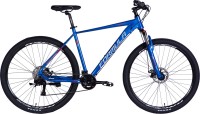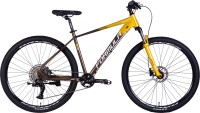Choosing a bike by frame size: 5 most important tips
We independently test the products and technologies that we recommend.

You can choose your own bike, both by frame size and other important parameters, in our general catalog.
When can a universal chart be used?
It is permissible to use a general chart for selecting a frame for a cyclist’s height in those rare cases when the manufacturer (brand) does not have its own size chart on the website and/or does not have an official representation on the Internet at all.
Most often, this is typical for budget bikes.In the case of these, the selection of a bike can be done according to this general chart:
 |
| Universal selection chart. |
Find the range that your height falls into and look at the frame size in centimeters, inches, or conventional units.
How to choose the right bike frame size?
Manufacturers whose class can be conditionally attributed to the middle or higher (not to mention advanced brands), necessarily have an official website and branded size chart.
On the description page of a particular bike model, look for the appropriate frame selection tab. This could be “geometry”, “size chart” or “geometry and size”, etc. Open the tab and select the frame to suit your height. This is what it looks like on the official website of the Author brand:
 |
| The frame selection tab on the Author website. |
For a given height (179 cm), the optimal frame size (18 ") is highlighted in red.
Why is a universal chart not the best solution when choosing a bike?
Reducing frame size selection to a single chart is problematic for several reasons:
- Different manufacturers use their own labels. For example, it is easy to understand centimeters and inches, but letters (conventional values) are often used - S, M, L, XL. Here each brand can have its own interpretation, which is due to different geometry (frame shape) for a particular type of bike, different fit.
- Each brand has its own engineers who develop (draw) frames. As a result, the brand chart is only suitable for models of one brand (and even then not for all).
- There are many types of bikes and each often has its own sizing chart. So, if you are interested in a road model, then the famous manufacturer Merida from Taiwan offers four different series of road bikes. A total of 18 charts can be made to fit adult models only:
 |
| Variety of Merida bikes. |
Almost every major manufacturer of bikes on the world market tries to be original, and not adhere to some uniform standards and universal sizes.
Let's take a closer look at the differences in the sizing charts of three famous brands: Merida, Giant and Cannondale:
Recommendations for road cyclists:
Merida:
 |
| Size chart for Merida road bikes. |
Giant:
 |
| Size chart for Giant road bikes. |
Cannondale:
 |
| Size chart for Cannondale road bikes. |
In this trio, from the first conditional sizes, the height range differs by 2 – 3 cm, and as the frame increases, the differences become more critical: already XL Merida is equal to L Giant. Taking into account the fact that users ride road bikes hundreds of kilometers every day, every centimeter can play a role.
You can also compare the frame sizes in cm of Cannondale and Merida. Thus, a value of 50 cm for an American manufacturer corresponds to a height of 162 to 166 cm (XS), and for a Taiwanese manufacturer – 163 – 172 cm (S).
For mountain bikes, these manufacturers have their own size charts. Let's look at them using the example of hard tails, that is, single-suspension models:
Merida:
 |
| Size chart for Merida single-suspension bikes. |
Giant:
 |
| Size chart for Giant single-suspension bikes. |
Cannondale:
 |
| Size chart for Cannondale single-suspension bikes. |
Here you just need to look at size M, after which serious differences are immediately visible:
- Merida has a frame size of 43 cm, optimal height is from 167 to 183 cm;
- Giant’s “M” is designed for users 171 – 180 cm;
- Cannondale's frame size is 18 " (45.7 cm), which is optimal for cyclists between 169 and 178 cm tall.
There can be no talk of universality. You need to select according to the specific brand and type of bike.
What about bikes for kids? Is there a universal chart?
For two-wheeled bikes for kids, the main selection criterion is usually the size of the wheels. But the so-called universal "one size" frame size is also often different for each manufacturer. For example, Giant's "one size" is designed for children from 105 to 125 cm tall. Cannondale's models for children are not based on height, but on age.
There is also no unanimity in the selection of wheel size. Here are just a few so-called "universal" size charts for children:
 |
| Another size chart for kids' bikes. |
If possible, it is better not to rely on such universal charts, because children grow quickly, every centimeter or inch is doubly important. The best option is to refer to the official website of the brand and find its size chart or recommendations for selection.
When the size of the wheels already exceeds 20”, then in addition to them, it is worth taking into account the size of the frame. Here it can range from 12.5 to 14". In addition, starting from a size of 20”, some manufacturers offer a division into urban, mountain and BMX bikes for children. Their geometry is also often different.
For bikes with a wheel size of less than 20" (in the absence of a branded size and/or official website of the manufacturer), it is permissible to select a model according to the following general chart:
 |
| Universal size chart of bikes for children. |
How else can you choose the right bike frame?
So, often universal charts for selecting frames for height are a waste of time. A separate, and most importantly, correct version can be made for a specific brand and type of bike. For selection, it is better to refer to the official website and familiarize yourself with the geometry of individual models.
Another option is to use Google and search through images. By entering a query like "bicycle brand sizing chart", replacing "brand" with a specific manufacturer, you can find size charts for various types of bikes, including road, mountain, urban bikes, etc.
It should also be noted that there is always a range of sizes "from and to", so for the same height, two frames, for example M and L, may be suitable. For children, it is customary to take the larger frame. Adults should consider the following factors:
- riding style. Fans of extreme riding are better off choosing a model with a smaller frame. It gives greater maneuverability. For quiet rides, it can be taken a larger frame;
- weight and build. Slim users should look for a larger frame that is suitable for their height, while larger and heavier users should go for a smaller frame. In the latter case, it will be easier to get on and off the bike and easier to handle;
- optimal frame height. For example, the distance from the frame when it is between the legs and the cyclist is standing on the ground to the groin area should be at least 5 cm. If this distance is less, the risk of unpleasant injuries from slipping off the saddle (e.g. during emergency braking or pedal slipping) increases;
- comfort. Personal feeling and comfort should be the deciding factor. This is why it is ideally worth testing several bikes in practice before making a final decision. In addition, users with special body types can always adjust the fit by adjusting the saddle and/or the handlebar angle.
Pay proper attention to frame selection and you'll be able to enjoy your ride. Good luck with your choice and enjoy your cycling adventures!
Articles, reviews, useful tips
All materials



























































































